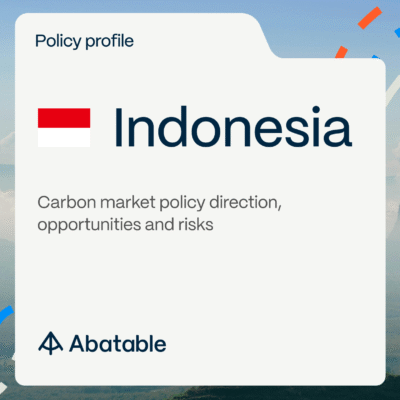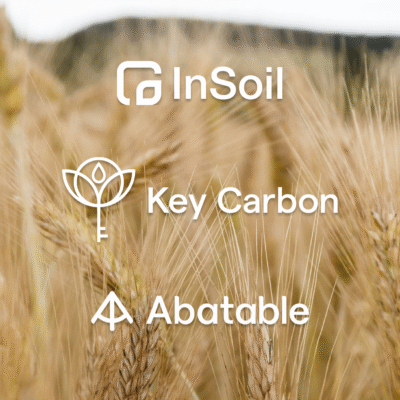Around 11,000 sustainability professionals descended on London’s Olympia last week for the inaugural Innovation Zero clean tech congress, endorsed by UK Prime Minister Rishi Sunak and organised in partnership with the UK government. Abatable was there on the ground, presenting, hosting sessions and exhibiting.
Following the congress we thought it would be useful for those who couldn’t make it, or indeed those who couldn’t get into the standing-room-only sessions, to summarise what we thought were some of the main takeaways from the bustling event.

Showfloor of the inaugural Innovation Zero conference. Image credit: Innovation Zero
Removals focus
Discussions about carbon removal projects and credits played a prominent role in the conference’s Voluntary Carbon Market (VCM) sessions. This was the case both in the events Abatable organised and in others we participated in.
Carbon removal credits can come from a variety of project types, including direct air capture (DAC), enhanced rock weathering, bioenergy and carbon capture, and storage projects, alongside nature-based techniques.
Carbon removals will play a critical role if we are to meet the Paris Agreement’s ambition to limit global temperature rises to 1.5C.
The relative lack of removal credits in the VCM, and the associated risk for companies that are planning on acquiring these as part of their sustainability efforts, came up as an issue repeatedly in conference sessions. Removal credits comprise around 7% of the VCM, with permanent removal credits currently representing only around 1% of credits available.
In some sessions, it was suggested that the Science Based Target initiative’s (SBTi’s) recommendation on carbon removals – that these (alongside avoidance credits) should be used to neutralise residual emissions following direct carbon reduction efforts – is spurring increased market interest in these credits.
Firms looking to secure removal credits should therefore act quickly, as Simon Manley, Head of Carbon at UNDO, remarked in Abatable’s carbon project developer fireside chat at the conference.

Abatable Co-Founder Maria Eugenia Filmanovic speaking with UNDO’s Head of Carbon Simon Manley (middle) and 1PointFive’s President and General Manager Steve Kelley (right) at Abatable’s carbon project developer fireside chat at Innovation Zero
UNDO specialises in enhanced rock weathering as a means of drawing down carbon from the atmosphere, and the firm is targeting one billion tonnes of CO2 removal by 2030. Enhanced rock weathering, while having challenges when it comes to measurement, reporting and verification, comes with significant co-benefits such as improved soil health and plant quality.
Manley stressed that time is of the essence for firms looking to buy removals due to this projected demand increase against a supply that is not yet there.
Engineered carbon removal schemes therefore present somewhat of a chicken-and-egg problem. With this increasing demand for removal credits, buyers need to be confident that future projects will materialise. But for this to happen, developers need buyer finance.
A well-functioning and transparent market will be key to facilitating this codependency, as the VCM is critical for making these projects financially viable. Corporate support will allow these technologies to scale and ultimately reduce their costs. As Shopify’s Head of Sustainability Stacy Kauk outlined in a separate session, long-term offtakes could pave the way forward for carbon removal project financing.
World’s largest DAC plant incoming
In Ector County, Texas, carbon capture firm 1PointFive has broken ground on what will be by some distance the world’s largest DAC project, expected to capture up to 500,000 tonnes of CO2 per year when it is completed in 2025.
Steve Kelly, President and General Manager at 1PointFive, outlined in Abatable’s fireside chat session the firm’s plans to build at least 100 large-scale DAC facilities across the globe by 2035. DAC technology is currently expensive, and the VCM, alongside US government support, is part of 1PointFive’s revenue stack to support the technology.
With parent company Occidental’s expertise in handling and storing CO2, Kelly said 1PointFive has a line of sight to scale and ultimately get costs down to $125 per tonne of CO2. He stressed that corporates getting removals into their portfolios is key to enabling this.
1PointFive’s plant will join other DAC projects such as Climeworks’ Orca, a 4,000 tonne-per-annum facility in Iceland, and its under-construction 36,000 tonne-per-annum Mammoth plant in the same location.
Empowering a thriving future
Halting emissions and removing CO2 from the atmosphere is just one part of the picture when it comes to addressing climate change.
As Abatable’s CEO & Co-founder Valerio Magliulo outlined on the Innovation Showcase stage, alongside the world’s rapidly declining global carbon budget we are also on the brink of a biodiversity crisis. On top of this, already-locked-in climate impacts will have an unequal impact on society, with the poorest 50% set to experience 75% of climate-related income losses.

Abatable CEO and Co-Founder Valerio Magliulo addresses the Innovation Showcase stage at Innovation Zero
To bridge the gap between our current emissions pathways and where we need to be to reach 1.5C, while also supporting projects that protect biodiversity, businesses will need to play a critical role.
We have the solutions, some of which are outlined above. However, as the Intergovernmental Panel on Climate Change has recently highlighted, many scalable options are costly and not viable without private finance, and supply is not where we need it to be. The chicken-and-egg problem appears again – how can businesses commit to these solutions when they don’t know where the supply is going to come from?
Moreover, market complexity and risk can hinder companies with net-zero ambitions effectively supporting both carbon avoidance and removal projects.
Enabling VCM transparency by standardising data and ensuring quality and integrity through due diligence and quality assessments can go a long way to solving this problem. This will help secure access to high-quality projects and enable firms to communicate their impact easily, spurring others to take action.
We believe market transparency and governance issues can be solved with these approaches, allowing private finance to bridge the emissions gap. This will help empower organisations to build a thriving future for climate, nature and people.
































































































